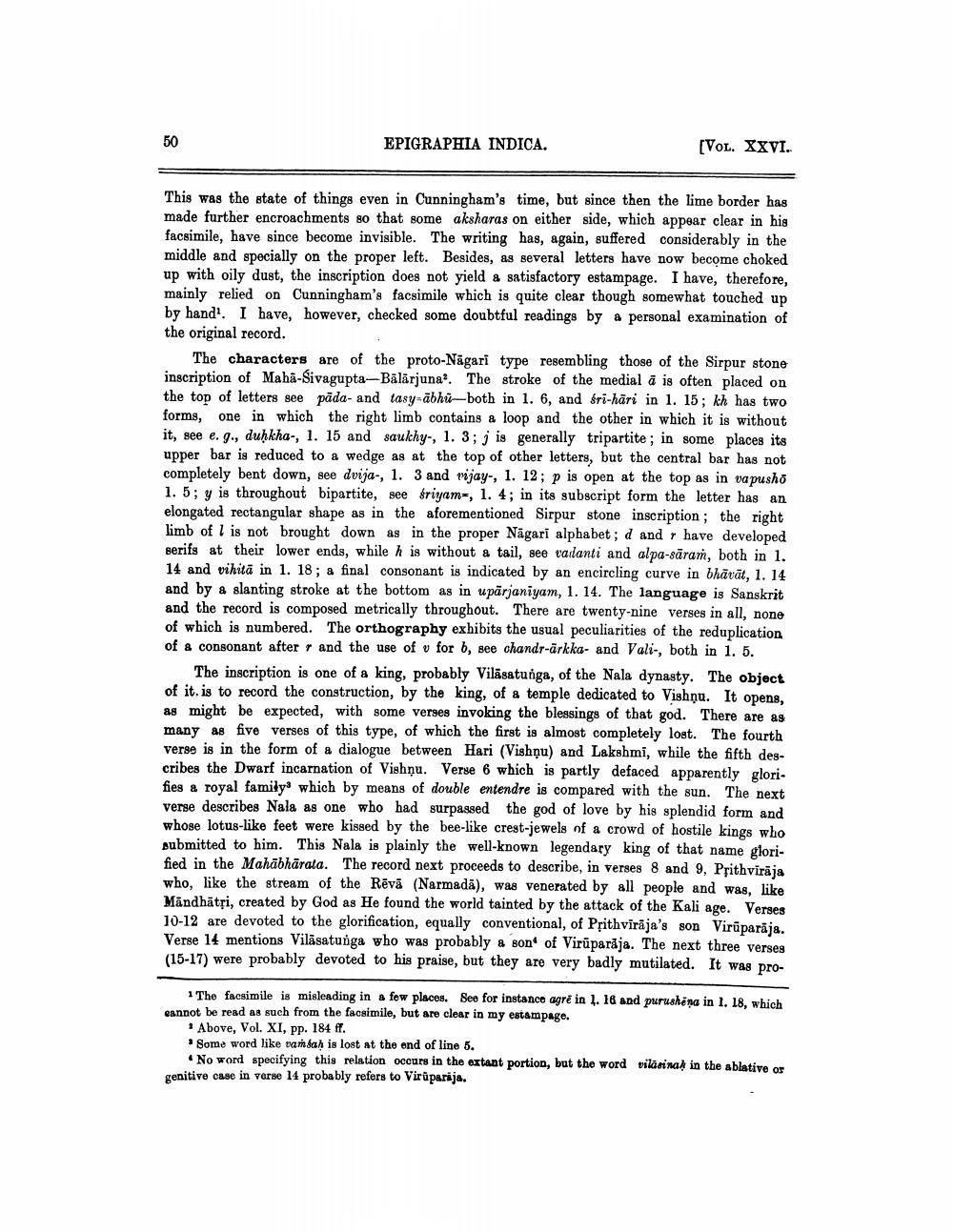________________
50
EPIGRAPHIA INDICA.
[VOL. XXVI.
This was the state of things even in Cunningham's time, but since then the lime border has made further encroachments so that some aksharas on either side, which appear clear in his facsimile, have since become invisible. The writing has, again, suffered considerably in the middle and specially on the proper left. Besides, as several letters have now become choked up with oily dust, the inscription does not yield a satisfactory estampage. I have, therefore, mainly relied on Cunningham's facsimile which is quite clear though somewhat touched up by hand. I have, however, checked some doubtful readings by a personal examination of the original record.
The characters are of the proto-Nagari type resembling those of the Sirpur stone inscription of Maha-Sivagupta-Bälärjuna'. The stroke of the medial a is often placed on the top of letters see päda- and tasy-abhu-both in 1. 6, and śri-hari in 1. 15; kh has two forms, one in which the right limb contains a loop and the other in which it is without it, see e. g., duḥkha-, 1. 15 and saukhy-, 1. 3; j is generally tripartite; in some places its upper bar is reduced to a wedge as at the top of other letters, but the central bar has not completely bent down, see dvija-, 1. 3 and vijay-, 1. 12; p is open at the top as in vapusho 1. 5; y is throughout bipartite, see śriyam-, 1. 4; in its subscript form the letter has an elongated rectangular shape as in the aforementioned Sirpur stone inscription; the right limb of is not brought down as in the proper Nagari alphabet; d and have developed serifs at their lower ends, while h is without a tail, see vadanti and alpa-saram, both in 1. 14 and vihita in 1. 18; a final consonant is indicated by an encircling curve in bhāvāt, 1. 14 and by a slanting stroke at the bottom as in upärjaniyam, 1. 14. The language is Sanskrit and the record is composed metrically throughout. There are twenty-nine verses in all, none of which is numbered. The orthography exhibits the usual peculiarities of the reduplication of a consonant after r and the use of v for b, see chandr-ärkka- and Vali-, both in 1. 5.
The inscription is one of a king, probably Viläsatunga, of the Nala dynasty. The object of it. is to record the construction, by the king, of a temple dedicated to Vishnu. It opens, as might be expected, with some verses invoking the blessings of that god. There are as many as five verses of this type, of which the first is almost completely lost. The fourth verse is in the form of a dialogue between Hari (Vishnu) and Lakshmi, while the fifth describes the Dwarf incarnation of Vishnu. Verse 6 which is partly defaced apparently glorifies a royal family which by means of double entendre is compared with the sun. The next verse describes Nala as one who had surpassed the god of love by his splendid form and whose lotus-like feet were kissed by the bee-like crest-jewels of a crowd of hostile kings who submitted to him. This Nala is plainly the well-known legendary king of that name glorified in the Mahabharata. The record next proceeds to describe, in verses 8 and 9, Prithviraja who, like the stream of the Revä (Narmada), was venerated by all people and was, like Mandhātri, created by God as He found the world tainted by the attack of the Kali age. Verses 10-12 are devoted to the glorification, equally conventional, of Prithviraja's son Viruparāja. Verse 14 mentions Vilasatunga who was probably a son of Viruparaja. The next three verses (15-17) were probably devoted to his praise, but they are very badly mutilated. It was pro
1 The facsimile is misleading in a few places. See for instance agre in 1. 16 and purushena in 1. 18, which cannot be read as such from the facsimile, but are clear in my estampage.
Above, Vol. XI, pp. 184 ff.
Some word like vam saḥ is lost at the end of line 5.
No word specifying this relation occurs in the extant portion, but the word vilasina in the ablative or genitive case in verse 14 probably refers to Viruparija.




